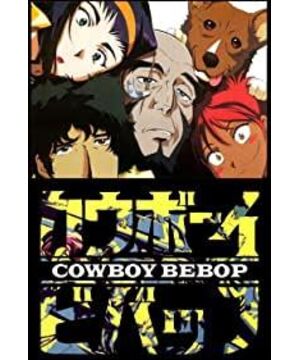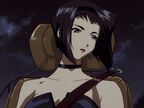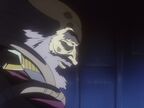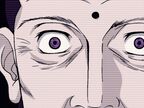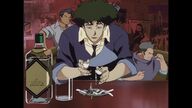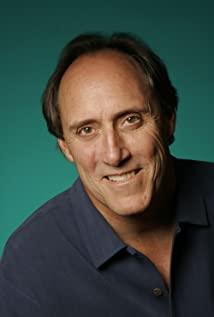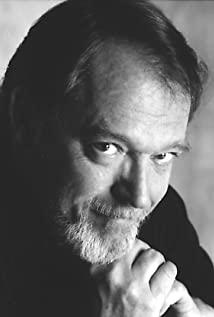B station address: [Secondary projector] see you cowboy! One of the greatest animations at the end of the 20th century, "Cowboy Bebop"
If you choose the greatest Japanese animation of the 20th century, "Cowboy Star" must be on the list. This animation, which was broadcast in 1998, is still very charming from the current point of view. Exquisite and delicate painting, three-dimensional and plump character images, imaginative but not an unreachable future world, smart and romantic BGM. It can be said that each staff member of "Cowboy Bebop" has contributed far beyond the industry average in their respective fields. Under the supervision of Shinichiro Watanabe, a near-perfect work was born into the world.
In 2021, with the realization of superluminal speed navigation technology, human beings will be able to move freely and conveniently within the scope of the solar system, but due to a design error, this technology caused the explosion of the moon, and countless lunar debris was attracted to the earth, causing An unprecedented catastrophe. The surviving humans escaped from Earth and began to establish homes across the solar system. Due to this disaster, the state, government and other power institutions are extremely unstable, and the issue of public security has also become a difficult problem. In order to catch criminals with insufficient human resources, some organizations began to allow individuals to catch wanted criminals in exchange for bonuses, and the profession of "bounty hunter" was born.
Spike and Jet are bounty hunters who pilot the spaceship Bebop in space to capture fugitives for prize money. During their interstellar journey, the two met Faye, who was in debt and thirst for money, and Ed, a computer prodigy, and adopted Ein, a data dog with a high IQ. Since then, four people and one dog have wandered in the vast universe, experiencing various joys and sorrows in their own and others' lives, and searching for their own pasts.
"Cowboy Bebop" was originally called "cowboy bebop" in Japanese, cowboy is a cowboy, and bebop is pop jazz. In fact, the meaning of this title is hidden in the OP animation of each episode. There is such a paragraph in the changing color background:
Once upon a time, in New York City in 1941...
At this club opens to all comers to play, Night after night,
At a club named "MINSTONS PLAY HOUSE" in Harlem,
they play jazz session competing with others.
Young jazz men with new sense are gathering.
At last, they created a new genre itself.
They are sick and tired of conventional fixed style jazz.
They eager to play jazz more freely as they wish. then...in 2071 in the universe.
The bounty hunters, who are gathering in spaceship "BEBOP",
will play freely without fear of risky things.
They must create new dreams and films by breaking t radical styles.
The work, which becomes a new genre itself, will be called... "COWBOY BEBOP"
A long time ago, in Harlem, New York in 1941, there was a bar called Minton's. The unrestricted stage welcomes anyone to come on stage to show their talents, so it attracts many young jazz musicians to gather here to make friends. Tired of the clichés of traditional jazz, these young souls finally created a new style to express their uninhibited true colors... In 2071, among the stars, a group of bounty hunters gathered on the 'Bebop' On the spaceship, the heart yearns for freedom and is not afraid of any danger. They will bring forth new ones and bring us a fantastic visual experience that we have never seen before. And this film that created a new style will also be named after it... "Cowboy Bebop"
As the text in the OP states, Cowboy Bebop has a unique style. A western movie staged in the boundless universe, green pepper shredded pork without shredded meat, the shape of the eastern world and the soul of western civilization. Supervising Shinichiro Watanabe allows those seemingly contradictory elements to blend harmoniously. "Cowboy Bebop" was born in the transition period of the Japanese animation industry from pure hand-drawn animation to the combination of hand-drawn and CG. They are all Japanese animation works that enabled CG technology earlier. Therefore, whether it is the plot technology or the plot content, "Cowboy Bebop" is worthy of the true meaning of its title. He did bring the audience a fantastic visual experience never seen before, and also created a new style of film.
The birth of "Cowboy Bebop" was largely influenced by the "Star Wars" series. In the 1990s, the reboot of the Star Wars series once again led to a spaceship boom in Japan. Bandai Hobby Division took advantage of the situation and asked Sunrise to make an animation that could attract audiences to buy spaceship models. So there was a project called "Flower Star ビバップ!". Supervisor Watanabe Shinichiro was inspired by the profession of bounty hunters in the United States, and provided this project with a near-future universe stage, a stateless world, and an emphasis on action scenes (audio is animated) to build "Cowboy Bebop" key assumptions of the world. When the planning book was officially handed over to the creator of this work, Kawamoto Riho, the name was changed to "shooting star bebop". The name that was not adopted by the TV animation was later used in the derivative comics of "Cowboy Bebop".
In the staff table of "Cowboy Bebop", only one name is written in the original column - Yatachi Hajime. In fact, this is a public vest, a "collective pseudonym" used by the Sunrise Planning Department to facilitate copyright management. "Cowboy Bebop" is a unit drama, and the script writer for each episode is different. Keiko Nobumoto, who constituted the series of the whole play, briefly described the plot of each episode in a few sentences when assuming the outline, and listed some elements that must be added. The creation of the detailed content is handed over to the script writers of each episode. The co-operation of the creators makes the character into a polyhedron, and the ten-person and colorful content style also enables each episode to bring a fresh experience to the audience. At the same time, in order to ensure the unity of the four protagonists in the whole work, the main creative team let the protagonists express their personalities in the way of "self-introduction" in the planning book. This enhances the author's understanding of the character. This method has also been carried over to the subsequent setting episodes, but the format has changed from the self-introduction of the protagonist group to an interview with Ed, but it looks just as cute and interesting.
Although it can be regarded as both fame and fortune now, the road to success for "Cowboy Bebop" has not been smooth. At the beginning of its birth, it was disliked by sponsors. From the point of view of music publishers, jazz has a relatively small market in Japan and is not the type of music preferred by the average animation audience. Even Yoko Kanno, the music producer of this work, said that "Jazz-based animation will definitely not sell." And from a toy maker's perspective, Cowboy Star isn't the kind of animation that's been asked to drive sales of spaceship models. Therefore, after seeing the early script of "Cowboy Bebop", Bandai withdrew its investment sponsorship for "Cowboy Bebop". At this time, Director Watanabe can be said to be the enemy. What's even more troublesome is that Sunrise is not very comfortable with this plan internally. Because the production cost of "Cowboy Bebop" is indeed a bit high, in the recollection of producer Nan Masahiko, the president of Sunrise at that time told him earnestly, "Don't bring down Sunrise". This series of problems has caused the broadcast of "Cowboy Bebop" to be delayed again and again.
The premiere of "Cowboy Bebop" on TV Tokyo was also not very smooth. First of all, due to scheduling issues, the content of the original 26 episodes was reduced to half the length. Later, due to the influence of the 3D Dragon incident and the assassination of a female teacher in Tochigi, many scenes were deleted and sprayed because they were identified as violent and pornographic content by the TV station, and some lines were also changed without the knowledge of the main creative team. In TV Tokyo's "Cowboy Bebop" episode 13, Session XX: Mish-Mash Blues, we can clearly feel the anger of supervisor Shinichiro Watanabe. The general episode is to summarize and sort out the previous plot, but Session XX uses the characters in the play to express the views of Supervisor Watanabe and the whole series, Nobuko Nobuko, on the deletion of the plot "THIS IS NOT THE END. YOU WILL SEE THE REAL "COWBOY BEBOP" SOMEDAY!", from this sentence, we can not only feel the sadness and anger of the main creative team, but also feel their determination, they will definitely bring the real "Cowboy Bebop" brought to the audience. Fortunately, the paid TV station WOWWOW gave help in the snow, and the full version of episode 26 finally saw the light of day. "Cowboy Bebop" has won many awards, including the 3rd Animation Kobe Works Award and the Nebula Award at the Japan Science Fiction Conference. From Asia to Europe and the United States, fans of "Cowboy Bebop" are distributed all over the world. From 2000 to 2005 alone, the DVD sales of "Cowboy Bebop" exceeded 1 million sets in the North American market. Become one of the few adult-oriented animation works that are repeatedly broadcast on North American television.
Many people say that Cowboy Star is a movie-like animation (audio is "movie version of animation"). In fact, the director Shinichiro Watanabe did treat each episode as an independent microfilm for production. Shinichiro Watanabe originally wanted to be a film director. Before working on Macross Plus, Kawamori had told him that an animation supervisor wouldn't have to endure the years of training and bureaucracy necessary for a live-action film director. It also prompted him to choose animation instead of developing in the live-action film industry. Watanabe Shinichiro's adolescence was deeply influenced by film and band culture, and the audience can feel the force of these two elements in almost all of his works.
During Watanabe's 2006 U.S. tour in Houston, he mentioned that "Cowboy Bebop" was the main inspiration for "Dirty Harry" and "Dragon Fight". In fact, there are quite a few movies that pay tribute to the TV version of "Cowboy Bebop". Just the element of Bruce Lee has repeatedly appeared in the animation countless times. At the beginning of the first episode, Spike's kung fu is Jeet Kune Do founded by Bruce Lee (ep01 02:45); another example is the bounty criminal who appeared in the second episode (ep02 02:28), his name comes from Bruce Lee's movie Game of Death, in which the character played by actor Kareem Abdul-Jabbar is called Hakim. Combining these two names is the name of the bounty criminal - ABDUL HAKIM. In the eighth chapter of "Cowboy Bebop", Supervisor Watanabe directly asked spike to quote Bruce Lee's famous line (ep08 07:48) "Be water, my friends.". Even on the copyright painting, spike reads books related to Bruce Lee.
In terms of playing terriers, "Cowboy Bebop" is not inferior to "The Daily Life of Pops and Pipi Beauty", and the number of neta contained in the 26-episode TV animation is outrageous. One of the most talked about is the tribute to the film "Alien" in episode 11. The lobster mutated due to improper preservation attacked the entire bebop. When they saw the detector and the gun, the audience who had the same interest as Superintendent Watanabe. Must be smiling. The structure of the four lessons is also very natural reminiscent of the four subtitles of "2001 A Space Odyssey". The space waltz at the end of this episode, the HAL-like electronic eye that appeared when Ed debuted in the episode, and the circular revolving bin in the bebop all point to Kubrick's classic masterpiece.
Superintendent Watanabe said this: the recent TV, movie and entertainment programs have talked too much, even if the sound is turned off, it can be understood. So I want to make something that speaks ten things in seven points. Therefore, Supervisor Watanabe never fully displayed spike's memory. We can only speculate from the fragmented flashbacks of what happened. In the fifth episode of "Cowboy Bebop", audiences get their first chance to learn about spike's past. The style of the fifth episode is very different from the first four episodes, and it is no longer the kind of lighthearted cosmic adventure. This is something I personally appreciate very much. The prototype of the church where Spike and vicious fought is the famous Notre Dame de Paris. The meeting between faye and vicous in the theater is taken from Hitchcock's 1956 film "The Catcher". The white dove is a tribute to John Woo's director of "Blood Two Heroes". In the song "green bird", spike smashed the stained glass of the church and slowly fell. This shot pays homage to the 1994 film The Raven.
In Cowboy Bebop, we can also see many familiar faces. Like Woody Allen, TOM and Jerry, Shinohara Tomoe, Master Yoda, George Clooney, and the blackened Goofy, there are too many neta in "Cowboy Bebop". corner. If you are interested in this part of the content, you can check the source of "Cowboy Bebop" uploaded by the main MatrixC7 of station B, the comments are very detailed.
Music is an extremely important part of Cowboy Planet. It is also the biggest source of inspiration for Watanabe's supervisory work. Director Watanabe doesn't like the cookie-cutter use of soundtracks, dogmatically using sad tunes with sad storylines. Therefore, there is no continuation of this rule in "Cowboy Bebop". Supervision Watanabe's soundtrack method is more objective, neither biased towards the protagonist nor the enemy. Describe the occurrence of events from the perspective of a third party. In the first episode, Katerina ended herself after shooting her lover. After a short silence, the harmonica sound did not deliberately mobilize the sadness of the audience. The camera turned to the usual jet and spike on the bebop, but the audience's emotions did not Stop fermentation. Really nice handling.
Since it comes to the music in "Cowboy Bebop", the topic must be inseparable from Yoko Kanno. During the creative process of "Cowboy Bebop", Shinichiro Watanabe handed over the music production to Yoko Kanno. In the previous "Macross Plus", the two have already collaborated. Therefore, it can be regarded as an old acquaintance. Yoko Kanno perfectly expresses the jazz with a midnight fascination and the smell of tobacco in the bar. Even people without any knowledge of music theory can feel how outstanding Yoko Kanno's musical talent is.
According to Riho Kawamoto, the character of Ed was actually inspired by Yoko Kanno. Because Director Shinichiro Watanabe felt that she was always doing nothing in the mixing room. But Yoko Kanno in Riho Kawamoto's heart is the one who composed the music for "Macross Plus" and "Esgaconi in the Sky", and a musician who can direct the entire band. So Kawamoto Riho fused this information together and extracted Ed's image - a cat-like genius. The pictures we are seeing now are Ed's abandoned cases. Ed was a boy throughout the planning stage. In the end, Ed can become a girl, thanks to Yoko Kanno.
Many viewers were bitter about Spike's ending. Even Spike's seiyuu Yamadera Hongichi couldn't control his emotions after the recording of the final words. Jet's seiyuu Yunsheng Ishizuka kept comforting him and said: Spike just passed out and fell asleep. As Superintendent Shinichiro Watanabe said in the interview, it is better to let the audience interpret the works freely, and the interpretation of the supervisor is not absolute. So today, 20 years after Cowboy Planet ended, we can still say, see you cowboy
View more about Cowboy Bebop reviews


